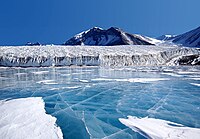The blue color is often wrongly attributed to Rayleigh scattering. Actually, the ice is blue for the same reason water is blue. Namely, it is a result of an overtone of a OH molecular stretch in the water which absorbs light at the red end of the visible spectrum.[1]
Runways
Blue ice is exposed in areas of the Antarctic where there is no net addition or subtraction of snow. That is, any snow that falls in that area is counteracted by sublimation or other losses. These areas have been used as runways due to their hard ice surface which is suitable for aircraft fitted with wheels rather than skis.http://en.wikipedia.org/wiki/Blue_ice_%28glacial%29

